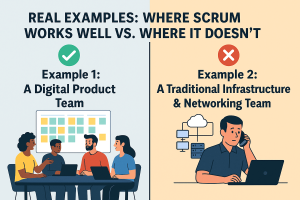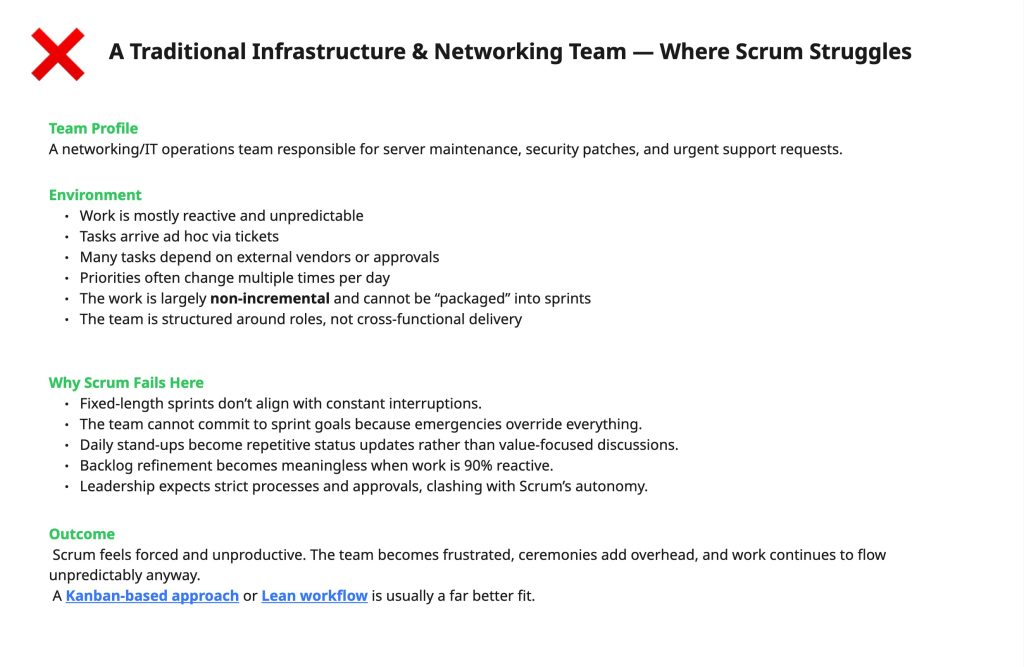
Is Scrum Right for Your Team? A Practical Guide to Making the Right Choice
Scrum is everywhere — from large enterprises to small digital teams. It promises faster delivery, better collaboration, and a structure that can respond to change. But one important question remains:
Is Scrum actually right for your company or team?
While it’s a powerful framework, Scrum is not a magic solution. It only works when the environment, culture, and goals align with how Scrum is meant to function. This guide breaks down the factors that help you determine whether Scrum will truly benefit your team.
What Scrum Really Is (and Isn’t)
Before deciding if Scrum fits your organisation, it’s important to understand that:
-
Scrum is a lightweight framework, not a full process.
-
It provides guiding rules and roles, but encourages teams to build on it.
-
It thrives in complex, changing environments where requirements evolve.
-
It is not suitable if you expect rigid control, fixed tasks, or strict hierarchies.
Many teams adopt Scrum because it’s popular — not because it fits their needs. The result? Frustration and failed “agile transformations.”
Let’s avoid that mistake.
Signs Scrum Is Right for Your Company

1. Your Work Changes Frequently
Scrum shines when priorities shift, customers change their minds, or the solution requires experimentation.
If your team deals with:
-
evolving requirements
-
iterative creative work
-
constant feedback loops
-
…Scrum is a strong candidate.
2. You Want More Collaboration
Scrum is built on communication, transparency, and team ownership.
Your team will benefit if you want:
-
more cross-functional work
-
regular feedback
-
better focus during Sprints
3. You Want Faster, More Reliable Delivery
Scrum breaks work into short, time-boxed cycles.
This allows you to deliver small, usable increments of value while keeping risk low.
4. Your Team Thrives with Autonomy
Scrum empowers teams to self-organise — not wait for permission.
If your team can take ownership and make decisions, Scrum will accelerate performance.
Signs Scrum Is Not Right for Your Company

1. You Expect a Rigid, Step-by-Step Process
Scrum intentionally avoids prescriptive instructions.
If your company wants a checklist or a strict sequence, Scrum may be frustrating.
2. Your Projects Are Highly Predictable
If the work has:
-
fixed requirements
-
minimal change
-
clear processes
… Waterfall or a hybrid might fit better.
3. Your Culture Is Hierarchical
Scrum requires:
-
transparency
-
open communication
-
trust in the team’s decisions
If approval layers are heavy or micromanagement is the norm, Scrum will struggle.
4. You Don’t Have a Full Cross-Functional Team
Scrum assumes your team can deliver an increment without depending on outside groups.
If your workflow is fragmented across many departments, Scrum needs organisational changes to work.
Where Scrum Works Well vs Where It Doesn’t
Understanding the theory is helpful — but the best way to see whether Scrum fits your company is to look at real-world scenarios. Here are two contrasting examples that show how dramatically the results can differ depending on the environment.

- Example 1: Where Scrum Works Exceptionally Well

- Example 2: Where Scrum Struggles

- Why These Examples Matter
These scenarios show the key truth:
Scrum succeeds only when the environment supports agility, collaboration, and incremental delivery.
- If your team’s work is predictable and structured, Scrum may feel burdensome.
- If your work is dynamic and exploratory, Scrum can unlock speed and innovation.

Key Questions to Ask Before Adopting Scrum
Use these questions as a quick diagnostic:
-
Are we ready to inspect and adapt frequently?
-
Can we deliver small increments of value every 1–4 weeks?
-
Do we have (or can we form) a real cross-functional team?
-
Are leaders willing to empower teams instead of directing every step?
-
Are we prepared for openness, transparency, and continuous improvement?
If most answers are “yes,” Scrum is a strong fit.
If many answers are “no,” the business may need to evolve before Scrum can work effectively.
What Happens When You Choose Scrum for the Wrong Reasons?
Common pitfalls include:
-
treating Scrum like a strict process (“Scrum-fall”)
-
doing ceremonies without purpose
-
forcing roles without changing culture
-
using Scrum only as a way to “get more out of people”
-
expecting instant results
Scrum only succeeds when the mindset matches the practice.
Hybrid Approaches: When Scrum Can Still Work
If your company wants some flexibility but not full Scrum, consider:
-
Scrumban (Scrum + Kanban)
-
Scrum with extended Sprint lengths
-
Scrum for R&D, Kanban for maintenance
-
Using Scrum events without formal roles
Scrum is adaptable — as long as changes still reflect its core values.
How to Decide: A Simple Checklist
If you tick these boxes, Scrum is likely right for your team:
✔ Work is complex and changes often
✔ You want collaboration, transparency, and adaptability
✔ Leaders support team autonomy
✔ You can build or already have a cross-functional team
✔ You prioritise iterative delivery
✔ You value continuous improvement
If not, consider whether your environment is ready — or whether another framework is better
Final Thoughts: Scrum Is Powerful, But Only When It Fits
Scrum can transform your company, culture, and delivery — but only when the conditions are right.
Choosing Scrum should be intentional, not automatic.
Evaluate your team, your environment, your goals, and your challenges.
If Scrum aligns with them, it can unlock speed, clarity, and true agility.
If not, many other agile and hybrid approaches might be a better fit.




